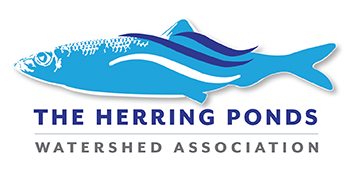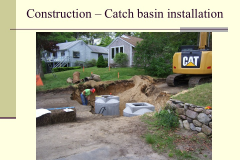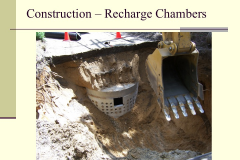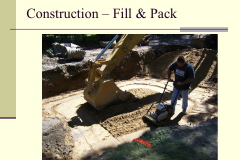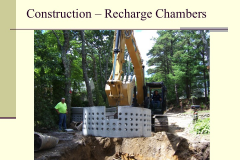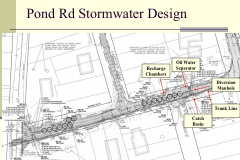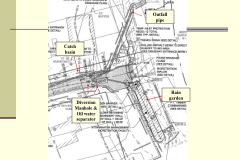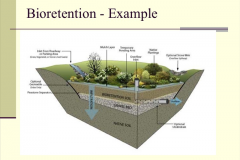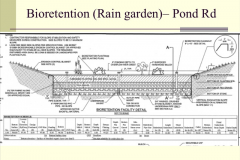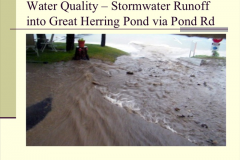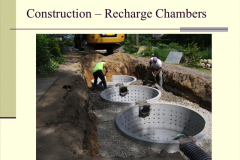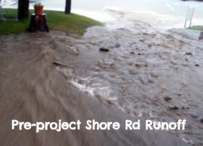 Storm water runoff can be a very serious source of pollution for water bodies. Whenever a major storm occurs, at first most of the rain will soak into the ground. But the more rain falls, and the more intense the rainfall is, the faster the ground saturates and will no longer be able to hold and absorb additional rain water. Instead it will stay at the surface and seek a way towards lower ground as runoff. In the process it will scrub and erode the soil, pick up sediment and dirt, animal waste, fertilizer, oil, and other contaminants, carry it with it, and eventually end up in the lowest part of the watershed, typically a stream or lake.
Storm water runoff can be a very serious source of pollution for water bodies. Whenever a major storm occurs, at first most of the rain will soak into the ground. But the more rain falls, and the more intense the rainfall is, the faster the ground saturates and will no longer be able to hold and absorb additional rain water. Instead it will stay at the surface and seek a way towards lower ground as runoff. In the process it will scrub and erode the soil, pick up sediment and dirt, animal waste, fertilizer, oil, and other contaminants, carry it with it, and eventually end up in the lowest part of the watershed, typically a stream or lake.
From 2009-2014 HPWA monitored storm water runoff by taking water samples during selected rain storms, just before they enter the ponds, and submitting them for analysis of pollutants and sediment. In addition, we are educating the public in ways they can help mitigate this source of pollution.
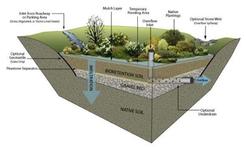 Around Great Herring Pond (GHP), there are mainly two kinds of runoff locations, man-made ones, with storm drains from roads and streets that have discharge pipes terminating at the lake shore, and natural ones, usually at steep shore configurations, where rainwater accumulates as little or not so little streams and discharges directly into the pond. There are also several locations where drainage canals or pipes from active or inactive cranberry bogs end up in GHP. Finally, there is Carter’s River, the stream connecting Little Herring Pond and GHP. At present, we are sampling storm water at the first two types of locations (see points labeled “R” on the map of Great Herring Pond).
Around Great Herring Pond (GHP), there are mainly two kinds of runoff locations, man-made ones, with storm drains from roads and streets that have discharge pipes terminating at the lake shore, and natural ones, usually at steep shore configurations, where rainwater accumulates as little or not so little streams and discharges directly into the pond. There are also several locations where drainage canals or pipes from active or inactive cranberry bogs end up in GHP. Finally, there is Carter’s River, the stream connecting Little Herring Pond and GHP. At present, we are sampling storm water at the first two types of locations (see points labeled “R” on the map of Great Herring Pond).
All our storm water sampling took place in the middle of a storm, as soon as possible after ½ inch of rain has fallen. This is because the first 1/8 – 1/4 inch of rainfall is absorbed into the ground, depending on the kind of soil and ground cover. Volunteer samplers were assigned to one (or two) location(s) near their home and were alerted by the sampling supervisor. Samplers got wet, but the payoff was great. The Town of Plymouth used the data to obtain funding for about a quarter million dollars for runoff mitigation in the Pond Rd. – Shore Rd. area of Great Herring Pond. This money has been spent on ducting, sediment traps, oil separators and a rain garden, all for filtering rain water before it reaches the pond. See photos below.
Details of our storm water sampling procedure are described in our Plymouth Pond and River Monitoring Program. Our first storm water collection during 2009 was done differently. At that time, all locations were visited by the same team.
Some runoff water analysis results: Storms suitable for sampling do not occur frequently. Nevertheless we have already completed a number of runoff samplings, and plan to do more. Results vary from location to location. We usually find e. coli loads very high, compared to regular water sampling. At most locations, phosphorus loads are also very high, indicating that runoff may be a significant source of harmful nutrients for algae blooms and aquatic plants. Acidity is higher than during regular water sampling. Somewhat surprising, conductance is low compared to regular sampling. We are not sure yet what some of our results indicate. Several locations carry lots of sediment in the samples.
